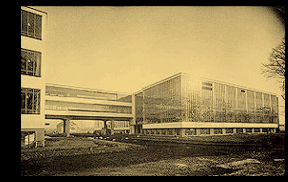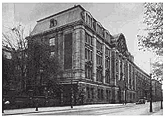 |
Artist
Richard Grune, who trained at the Bauhaus school in Weimar under teachers including Paul Klee and Wassily Kandinsky, moved to Berlin in February 1933.
|

Richard Grune, ca. 1922.
|
 |

Walter Gropius, Bauhaus Dessau, 1925–26. View from the Northwest. Photo Lucia Moholy, 1926. Bauhaus-Archiv Berlin. © 2002 Artists Rights Society (ARS), New York/ VG Bild-Kunst, Bonn
|
|

|
Between
1933 and 1945, Germany's Nazi government under Adolf Hitler attempted to rid German territory of people who did not fit its vision of a "master Aryan race." Grune and other homosexuals in Germany felt the impact of the new regime within weeks of Adolf Hitler's appointment as chancellor in January 1933.
|
|
|
|
|
|
|
In
February, police and Storm Troopers began enforcing orders to shut same–sex bars and clubs. During a crackdown over the next several months, most gathering places for homosexual men and women were closed down, fundamentally disrupting their public lives. Grune was arrested in December 1934, one of 70 men caught in a wave of related denunciations.
|
|
|
Under
interrogation, Grune admitted to being homosexual. He was held in "protective custody" for five months, then returned to his childhood home on the German–Danish border to stand trial for violating Paragraph 175. In September 1936, Grune was convicted and sentenced to prison for one year and three months, minus time already served in protective custody. It is estimated that some 50,000 men served prison terms as convicted homosexuals.
|
|
|
|
|
At
his release, the Gestapo returned Grune to protective custody, asserting that the sentence had been too lenient. In early October 1937, Grune was sent to the Sachsenhausen concentration camp, where he remained until being transferred to the Flossenbürg camp in early April 1940.
|
|
|
World
War II helped to conceal the Nazis' radicalized persecution at home. Thousands of homosexuals were sent to forced labor camps. There, in an explicit campaign of "extermination through work," homosexuals and other so-called security suspects were assigned to grueling work in ceaselessly dangerous conditions.
|
|
|
|
|
Grune
himself remained in the Flossenbürg camp until 1945. As American forces approached, he escaped the evacuation of Flossenbürg and joined his sister in Kiel. He spent much of the rest of his life in Spain, but later returned to Kiel, where he died in 1983.
|
|
|
Richard
Grune's desire to bring attention to the terror of the concentration camps led to the 1947 publication of a limited–edition portfolio of his lithographs. His work generally reflects what he experienced at the Sachsenhausen and Flossenbürg concentration camps; some images are based on information from other survivors. The portfolio is among the most important visual recordings of the daily nightmare of the Nazi concentration camps to appear in the immediate postwar years.
|
|
|
